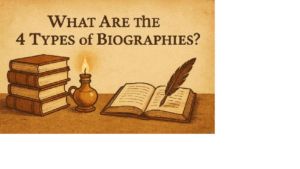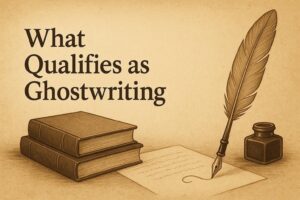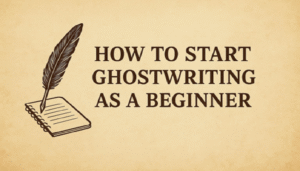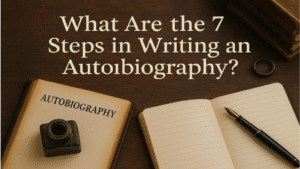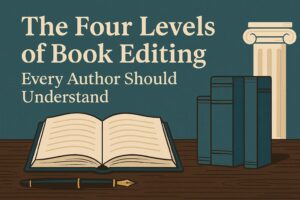Introduction
Here’s a strange truth about writing someone’s life story: the more you learn about them, the harder it gets. At first, you think you’re chasing facts. But then the facts multiply like squirrels in a park, darting in every direction, begging for attention. Pretty soon, you’re sitting there wondering how anyone ever decides what to include in a biography without losing their mind.
If you’re feeling that swirl of confusion, you’re not alone. Most people think a biography is about gathering more information, when really it’s about making sharper, braver choices. Lives are messy. Lives are crowded. Lives are full of details that look important but aren’t. The real skill is knowing which ones reveal the person and which ones just take up space.
I’ve helped writers, students, and storytellers break down overwhelming life stories into clear, meaningful narratives. And in this guide, you’ll get a structure that makes the whole process feel doable. You’ll understand the essential facts, the narrative beats, the emotional layers, and the context that turns a human life into a readable story.
By the end, you won’t just know what to add. You’ll know what to cut and why.
Core Identifying Facts Every Biography Should Include
Before you dive into scenes, turning points, or emotional depth, you need the concrete facts that anchor a life story. Think of these details as the spine of the narrative. Without them, the structure collapses. Even a biography writing company starts here because these pieces help readers understand who the person is at the most basic level.
1. Basic Personal Data
Start with the essentials that identify the person clearly and accurately.
- Full name and any former names or pen names
- Date and place of birth
- Date and place of death if relevant
- Nationality or cultural background when it adds context or meaning
These are simple but non negotiable. They set the foundation.
2. Family and Early Environment
Family shapes everything from mindset to opportunities. Include:
- Parents or primary caregivers
- Siblings or meaningful family figures
- Socioeconomic background such as rural or urban setting, wealth or poverty, or experiences of immigration
- Major family events like migration, illness, loss, or conflict
These details help readers understand the world the person grew up in.
3. Education and Training
List the schools, universities, or programmes that mattered. Also consider:
- Degrees or qualifications
- Informal learning like apprenticeships, mentorships, or self study
- Training that shaped their skills or worldview
This section shows how the person learned to become who they eventually became.
4. Career and Roles
Outline the work the person is known for. This might include:
- Primary professions or roles
- Major positions or organizations
- Notable career shifts or reinventions that changed their life path
This helps readers track professional growth and purpose.
5. Key Accomplishments and Recognition
This is where achievements come into focus. Include:
- Books, inventions, discoveries, artworks, companies, or movements
- Public awards or honors
- Concrete examples of influence such as laws changed, industries shaped, or communities helped
These details reveal why the person matters.
Life Story Building Blocks: How to Turn Facts Into a Narrative
Facts alone won’t carry a biography. To make a life story feel alive, you need movement, emotion, and change. Even ghost book writers rely on these core narrative beats because this is what transforms information into an actual story someone wants to read.
1. Origins and Childhood
Start with where it all began.
- Where they grew up, what the world looked like around them, and what was happening historically.
- Early traits or quirks that hinted at who they might become.
- Childhood experiences that shaped their values or redirected their path.
Small details here can pull a reader in fast.
2. Adolescence and Early Adulthood
These years often reveal the first real signs of independence. Include:
- Education transitions like high school to college or college to the workforce
- First serious jobs, creative attempts, or political involvement
- Mentors, early partners, or friendships that guided them
This phase often sets the tone for their future direction.
3. Turning Points and Crises
Every meaningful life has moments when everything shifts. Highlight:
- Failures, breakthroughs, illnesses, accidents, or unexpected opportunities
- Decisions that changed their trajectory such as moving cities, changing careers, or starting something new
- Internal struggles like self doubt, ambition, fear, or clarity
These turning points provide emotional weight.
4. Mature Years and Peak Contribution
This is the heart of the story. Include:
- Their most influential work
- Communities, rivals, or collaborators who shaped their direction
- Challenges they faced at the height of success like criticism, burnout, or public pressure
This section shows what they stood for and how they made their mark.
5. Later Life, Legacy, and Impact
Wrap up with what the person left behind.
- How they spent their later years
- Circumstances of death if relevant
- How people view them now and the long term impact they left on culture, science, politics, art, or everyday life
This brings the narrative full circle.
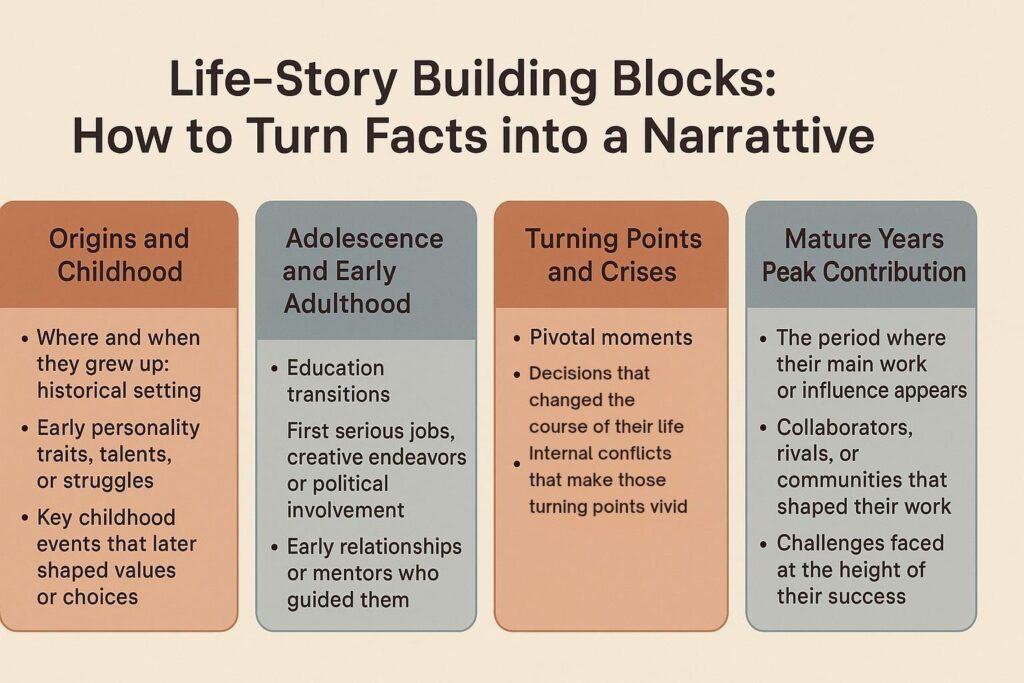
Context Details That Make a Biography Feel Real
A biography becomes richer when you show the world the person lived in, not just the events of their life. These details give readers texture, mood, and clarity about why certain choices mattered. They also help when you’re figuring out what to include in a biography, especially when you want the story to feel grounded and human.
1. Historical, Cultural, and Political Context
Show the bigger landscape around the person. Include:
- Major historical events that shaped their experiences such as wars, social movements, or economic shifts
- Cultural trends like music, art, technology, or religion
- Any public attitudes or tensions that influenced their decisions
This background answers the question: What world shaped them?
2. Places and Settings
Place affects identity more than most people realize. Highlight:
- Cities, neighborhoods, or countries that played an important role
- Schools, workplaces, or communities they spent time in
- Moves or migrations that marked turning points
Locations help anchor the reader emotionally and visually.
3. Social Circles and Communities
People rarely evolve alone. Add details about:
- Creative circles, scientific groups, social movements, religious communities, or professional networks
- Friends, collaborators, guides, or even rivals
- Any relationships that pushed, challenged, or inspired them
These details show the influence of the people around them and help readers understand the social forces shaping their life.
Inner Life: The Invisible Details That Biographies Should Cover
The inner world is where a biography stops feeling like a timeline and starts feeling like a person. These are the details that reveal motivation, desire, fear, and contradiction. Even a biography writing company knows that without inner depth, a life story feels flat no matter how many facts you stack on top.
1. Values, Beliefs, and Motivations
Show what drives the person from the inside out.
- Their political, religious, or ethical beliefs
- How those beliefs changed over time
- What pushed them forward such as justice, ambition, curiosity, love, or survival
These reveal the “why” behind their choices.
2. Personality and Character
Readers need to feel who the person was. Include:
- Habits, quirks, routines, or rituals
- Whether they were loud or quiet, disciplined or chaotic, warm or blunt
- Patterns in how they interacted with others
These details add warmth and dimension.
3. Internal Conflicts and Contradictions
Every human is complex. Show the tensions between:
- Public image and private identity
- What they wanted and what they feared
- The regrets they carried or the doubts they fought through
These contradictions make the story honest and relatable, and they’re often refined carefully through biography editing services to preserve accuracy while keeping emotional truth intact.
Evidence, Sources, and Texture: How to Support the Key Details
A biography is only as strong as the evidence behind it. Without solid sourcing, a life story starts to wobble and lose credibility. Readers can feel when details are vague, exaggerated, or uncertain. This is why research is the backbone of any well written biography. Even a ghost book writer depend on careful sourcing to build a story that feels trustworthy, grounded, and compelling.
1. Research Foundations
Start with the materials that give you the most direct access to the person’s life.
- Primary sources are your first stop. These include letters, journals, diaries, emails, speeches, interviews, legal documents, and official records. They give you the person’s voice, thoughts, and experiences in their own words.
- Secondary sources help you understand how others interpreted the person’s life. These include previous biographies, historical texts, documentaries, news articles, and scholarly analysis.
- Good research blends both. Primary sources bring you close to the person. Secondary sources help you place their life in context so you can tell a story that feels complete and honest.
2. Quotes, Anecdotes, and Scenes
Evidence becomes more powerful when you bring it to life through scene building.
- Direct quotes give readers the person’s actual voice. A single sentence they wrote or said can reveal personality, fears, humor, or conviction in ways simple description cannot.
- Anecdotes show instead of tell. They reveal traits and motivations through moments that feel real. A childhood story, a professional misstep, or a personal victory can add emotional depth and help readers understand why certain events mattered.
- Scene details such as what a room smelled like, what someone wore, how a conversation unfolded, or how a place looked add texture. These sensory details make the biography immersive, helping the reader picture the world the person lived in.
3. Visual and Supporting Material
Visual elements can deepen understanding and keep readers engaged. Include:
- Photographs that show important moments or phases of life
- Captions that clarify what readers are looking at
- Copies of letters or handwritten notes that reveal personality
- Timelines that help readers follow events clearly
- Maps that show migrations, travels, or major life moves
- Family trees that clarify complex relationships
These tools help readers navigate a life story that might span decades, continents, or major historical shifts.
A well researched biography doesn’t just present facts. It creates an experience. The stronger your evidence, the more confidently readers can step into your subject’s world.
Tailoring the Details to Biography Type and Audience
Not every biography serves the same purpose, so the amount of detail you include must match the needs of your audience. When you understand the purpose of the biography, it becomes much easier to decide what to include in a biography and what to set aside. The sections below break down how to adapt your content to different formats so the story stays focused, compelling, and appropriate for its readers.
Full Length Narrative Biography
A full length narrative biography gives you the broadest canvas. This format allows you to follow a person from childhood to legacy, capturing the emotional highs, the quiet moments, and the turning points that shaped their character. In this type of biography, you can explore the social and historical context around them, paint scenes that draw readers in, and analyze their internal conflicts with depth.
You can cover long term themes such as ambition, reinvention, identity, resilience, or community. You can show how the person interacted with mentors, rivals, supporters, or critics. You can also include longer quotes, vivid anecdotes, and moments that bring the person to life. Because the format is spacious, it supports a rich blend of storytelling and research. This type of biography works best when the goal is not just to inform the reader but to immerse them in the life of the subject.
Short School or Student Biography
A short school biography has a much simpler purpose. It is designed to introduce students to an important figure without overwhelming them. This format sticks to the essentials such as birth, family background, education, major achievements, and death if relevant. You can include one or two interesting or inspiring stories, but the structure remains clear and factual.
The goal is comprehension. Students should walk away knowing why the person matters historically or culturally. These biographies avoid deep psychological analysis and focus on straightforward information that is easy to read and easy to remember.
Professional Bio for Websites, LinkedIn, or Book Covers
A professional bio has a completely different tone. It is not a narrative. It is a snapshot of credibility. In this format, you highlight the person’s name, role, skills, and most important accomplishments. You may include certifications, years of experience, or key achievements that build trust with the reader.
This type of bio often ends with one short personal detail such as a hobby or value. The writing is quick, clear, and confident. It serves people who need to know who you are and why they should trust your expertise without reading a long story.
Academic or Research Bio
An academic bio focuses on scholarly credibility. It starts with the person’s academic position and institution. After that, it highlights research areas, published work, grants, awards, and long term academic goals. The tone is formal and precise, and it follows the expectations of universities and research institutions.
A touch of personality is fine, but the emphasis stays on contributions to the academic field. This type of biography is used in journals, conferences, department pages, and grant applications, so accuracy and clarity matter above all else.
Deciding What to Leave Out: Relevance, Privacy, and Accuracy
Knowing what to include is only half the job. A strong biography also depends on knowing what to remove. When you cut the right things, the story becomes clearer, tighter, and more meaningful. When you leave in every detail, the narrative becomes cluttered and overwhelming. These guidelines help you decide what stays, what goes, and why it matters.
1. Relevance to the Central Theme
Every biography has a core theme or idea running through it. It might be resilience, creativity, leadership, survival, reinvention, or something more specific to the individual. Once you know the central theme, you can filter every detail through a simple question: Does this move the story forward?
Minor childhood events, repetitive achievements, or small conflicts often distract from the bigger narrative. Instead of listing every event, group similar moments together. Summaries can be more powerful than long explanations when the details do not change the reader’s understanding of the person.
2. Respecting Privacy and Ethics
Biographies are built on real lives. That means you carry a responsibility to treat the subject with fairness, especially if they are still alive. Avoid including deeply personal information that feels sensational or unnecessary. Medical details, financial struggles, or intimate relationships should only be used when they truly shape the person’s story or explain an important choice.
Ethical writing is about balance. You should tell the truth without causing harm. If a detail feels intrusive or disrespectful, think twice before using it. Sometimes a brief mention is enough. Sometimes it does not belong at all.
3. Verifiability and Reliability
Accuracy is the backbone of any biography. If a detail cannot be verified by reliable sources, consider leaving it out. Rumors, unconfirmed stories, or contradictory accounts can weaken trust and make the narrative feel unstable. When you do include information with conflicting sources, acknowledge the uncertainty so the reader understands the context.
If you are unsure about a piece of information, ask: Is this detail essential to the story? If the answer is no, removing it may strengthen the biography. If the answer is yes, keep researching until you find the most credible version.
Step by Step Checklist: Gathering the Key Details for a Biography
A strong biography does not start with writing. It starts with gathering, sorting, and understanding information with intention. A good checklist gives you direction, keeps you focused, and makes it easier to see what to include in a biography without drowning in unnecessary details. This expanded guide walks you through each step so you can move from scattered notes to a clear and compelling life story.
1. Clarify Your Purpose and Audience
Before you begin, take a moment to understand why you are writing the biography and who will read it. A biography for a school assignment is simple and fact based. A book length biography requires more depth, analysis, and storytelling. A professional bio calls for clarity and authority. An academic bio focuses on research and expertise. When you know the purpose, you know the tone, scope, and level of detail you need. This prevents you from collecting information that does not serve your reader.
2. Collect Core Facts
These basic facts form the backbone of the biography. Start with the person’s full name, birth and death details, nationality, and cultural background. Add immediate family details such as parents, siblings, or important caregivers. Then record education, major roles, and key accomplishments. These foundational details never change, no matter the type of biography you write. They create the structure on which everything else is built.
3. Map Out Life Stages
Breaking a life into stages helps you see the natural flow of the story. Label each stage clearly such as childhood, adolescence, early adulthood, peak years, and later life. This makes your research feel organized and helps you see where major events fall. It also prevents the story from jumping around and confusing the reader. Life stages make it easier to build a timeline that feels logical and satisfying.
4. Identify Themes and Turning Points
A biography is more than a list of events. It is a story shaped by themes and major shifts. Themes could include courage, creativity, leadership, loss, identity, or reinvention. Turning points are moments when the person made a choice or faced an event that changed their path. These could be breakthroughs, failures, moves to new places, new relationships, or sudden opportunities. When you identify these moments early, you understand the emotional arc of the biography.
5. Research Context and Community
A life does not happen in isolation. Look for historical events, cultural movements, and political environments that influenced the person. Then explore the people around them such as family members, mentors, partners, rivals, or collaborators. Context gives meaning to choices and struggles. Community reveals support, conflict, or inspiration. These details help readers see the world the person lived in, not just the facts of their life.
6. Explore Inner Life and Personality
A biography becomes truly engaging when you understand what the person felt and believed. Look for their values, fears, motivations, and personal contradictions. Search for journals, interviews, or quotes that reveal how they thought. Explore their habits, quirks, strengths, and flaws. These human details help readers connect emotionally with the subject.
7. Gather Quotes, Anecdotes, and Visuals
Stories bring a biography to life. Collect memorable quotes, personal anecdotes, and vivid scenes that reveal character. Add photos, letters, handwritten notes, or documents when appropriate. These elements create immersion and make the biography feel real and textured.
8. Decide What to Cut
After you gather everything, take time to refine. Remove details that repeat, distract, or feel irrelevant. Protect privacy and avoid information that feels sensational. Keep the facts that support the story you are telling. A strong biography is shaped as much by careful removal as by thoughtful inclusion.
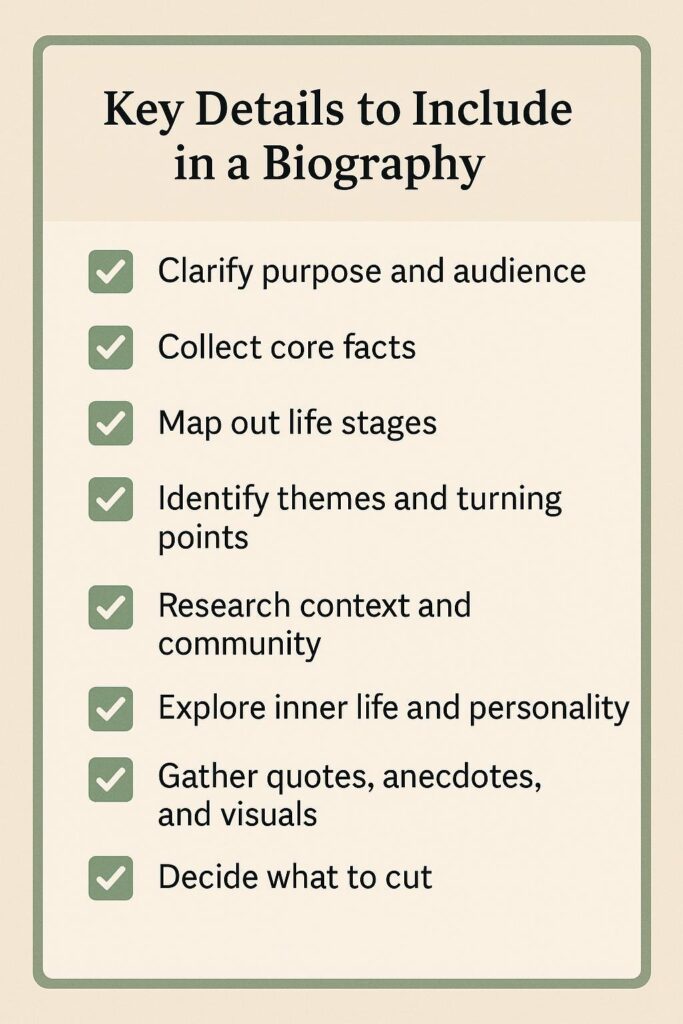
FAQs
How long should a biography be, and does that change what I include?
Length depends on purpose: a school assignment might be 500–1,500 words, a book-length biography can run hundreds of pages. The longer the work, the more room you have for context, scenes, and inner life; shorter pieces should stick to core facts, 1–2 key stories, and a clear explanation of why the person matters.
What are the absolute “must have” details in any biography?
At minimum: full name, date and place of birth (and death, if applicable), family/early life in brief, education or training, main career or role, major achievements, and a sentence or two about impact or legacy.
How many personal or private details should I include?
Include private details only when they illuminate the person’s character, choices, or impact, and when you can handle them accurately and respectfully. For living subjects, prioritize consent and avoid details that feel gratuitously invasive or sensational.
Do I have to cover the person’s entire life, or can I focus on one period?
Many biographies focus on a specific era (e.g., “early years in Paris” or “time as CEO”) as long as readers still understand the basic background and later impact. The key is clarity: explain why you’re focusing on that period and how it fits into the person’s larger life arc.
How do I keep a biography from becoming just a list of dates and facts?
Any professional ghost book writer overcomes this issue by using narrative techniques: scenes, dialogue (when supported by sources), and specific anecdotes to bring facts to life. Arrange details around themes and turning points rather than listing them chronologically like a CV.
What’s the difference between a professional bio and a full biography in terms of details?
A professional bio is short and focused on current role, expertise, notable achievements, and a touch of personal color. A full biography covers all major life stages, context, inner life, and long-term legacy.
Conclusion
Writing a biography is never just about collecting facts. It is about choosing the details that reveal a life, shape a story, and help readers understand who a person truly was. When you know what to include in a biography, the entire process becomes clearer and more intentional. You stop guessing and start selecting with purpose.
A strong biography blends foundational facts with meaningful context, turning points, personal values, and moments that show the human side of the subject. It respects privacy, relies on credible sources, and stays focused on the central themes that define the person’s journey. Whether you are crafting a full length narrative, a short student assignment, a professional bio, or an academic profile, the same principle guides them all. Include what serves the story, and leave out what distracts from it.
At the end of the day, a biography is more than a record. It is a bridge between the reader and the life being told. When you build that bridge with intention, honesty, and clarity, the story becomes one worth remembering.
If you want, I can now format the entire blog for you in MLA headings or prepare it for publishing.




